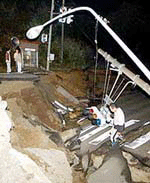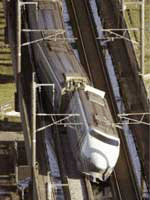Japan Quake Kills 18, Another 1,500 Injured
2004 10 24
 By Hiroyuki Muramoto - Reuters By Hiroyuki Muramoto - Reuters
OJIYA, Japan (Reuters) - Strong aftershocks shook northern Japan on Sunday after the country's deadliest earthquake in nine years killed at least 18 people and injured some 1,500 as houses collapsed, roads crumbled and rail tracks buckled.
Thousands of frightened residents in rural Niigata prefecture huddled in shelters or stayed outdoors after fleeing the initial 6.8 magnitude quake at 5:56 p.m. (4:56 a.m. EDT) on Saturday.
Many landslides hit the largely mountainous region some 150 miles north of Tokyo, including one that devastated a village and cut off 600 residents.
The quake, coming hard on the heels of a typhoon that killed at least 80 people last week, is the deadliest in Japan since the Kobe earthquake killed more than 6,400 in 1995.
"Our 'life-line' has been cut. There is no toilet, gas or electricity and it was cold last night," Toshiro Hosoya, 57, a high school teacher in Ojiya, told Reuters.
"I'm not terrified, but the aftershocks keep coming, so I have a strange feeling of unease."
Soldiers in khaki uniforms were shown on television trying to rescue a mother and son trapped in a house wrecked by a landslide, using chain saws to cut their way through the rubble.
In the city of Ojiya, the scene of much of the damage, a large area of land under a rail line had caved in, forming a crater-like hole and leaving train tracks dangling. People picked their way on foot along heaved and broken roads.
"We are desperately in need of food, water and blankets for the local residents," said an official in Ojiya, a textile center which has a population of about 40,000.
In Tokyo, where the government has set up a crisis center, officials said they were trying to arrange to transport food and other necessities as soon as possible.
In a part of Ojiya cut off by landslides, residents had written 'SOS' on the road in big letters that could be seen from the air. Soldiers were seen helping people to a helicopter.
 In the city of Nagaoka, the lopsided front carriage of a bullet train rested on the side of its track, the first derailment since the high-speed service began 40 years ago. In the city of Nagaoka, the lopsided front carriage of a bullet train rested on the side of its track, the first derailment since the high-speed service began 40 years ago.
There were no injuries, a Transport Ministry official said.
The quake knocked out power to at least 278,000 homes, although by morning some electricity had been restored.
Water, gas and phone services were disrupted and operators limited mobile phone use to ensure emergency calls got through.
The quake and aftershocks shook buildings in Tokyo but there were no reports of any injuries or major damage in the capital.
Officials have estimated that a quake of similar scale in the Tokyo area would kill about 7,000 people.
TERRIFYING NIGHT
Small local hospitals overflowed with injured, some of whom were being treated in hallways.
Many residents huddled under blankets in schools and other temporary shelters while some spent the night outside or in cars as temperatures fell to around 41 degrees.
More than 250 aftershocks that could be felt by humans had struck since the initial quake, the Meteorological Agency said, and officials warned of more strong tremors.
The dead in Niigata, a rice-growing region bordering the Sea of Japan, included an elderly woman who died of shock and a two-month-old infant, national broadcaster NHK reported.
Three children were killed when their houses collapsed.
A total of 67,000 people were evacuated to schools and other public facilities, NHK said.
Rice balls, bread and water were being delivered to evacuees by troops and other rescue workers. In one village, residents cooked meals and rested on bits of cardboard in the road.
There were no reports of significant damage to industry in the region, which includes chemical and textile manufacturing as well as electronics and food processing, although some factories had halted production and damage to roads and railways raised concerns about distribution bottlenecks.
Firms with operations in the area include Matsushita Electric Industrial Co., maker of Panasonic products, as well as consumer electronics group Sharp Corp. and Shin-Etsu Chemical Co. Ltd.
Officials warned of more landslides in areas hit recently by heavy rains from the record 10 typhoons to hit Japan this year.
Prime Minister Junichiro Koizumi told reporters the quake "must be beyond our imagination in terms of fear and damage."
An extra budget would almost certainly be needed to help cope with the disasters, media reports said.
The quake's magnitude was measured according to a technique similar to the open-ended Richter scale but adjusted for Japan's geological characteristics.
Japan is one of the world's most seismically active areas, accounting for about 20 percent of the world's earthquakes of magnitude six or greater.
Article From: http://www.earthchangestv.com/secure/2004/article_4585.php

|
